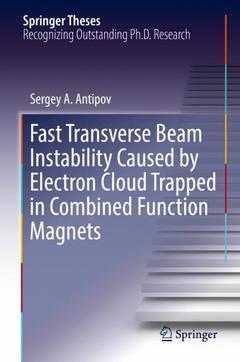Fast Transverse Beam Instability Caused by Electron Cloud Trapped in Combined Function Magnets, 1st ed. 2018 Springer Theses Series
Auteur : Antipov Sergey A.

This thesis presents profound insights into the origins and dynamics of beam instabilities using both experimental observations and numerical simulations. When the Recycler Ring, a high-intensity proton beam accelerator at Fermi National Accelerator Laboratory, was commissioned, it became evident that the Recycler beam experiences a very fast instability of unknown nature. This instability was so fast that the existing dampers were ineffective at suppressing it. The nature of this phenomenon, alongside several other poorly understood features of the beam, became one of the biggest puzzles in the accelerator community.
The author investigated a hypothesis that the instability arises from an interaction with a dense cloud of electrons accompanying the proton beam. He studied the phenomena experimentally by comparing the dynamics of stable and unstable beams, by numerically simulating the build-up of the electron cloud and its interaction with the beam, and by constructing an analytical model of an electron cloud-driven instability with the electrons trapped in combined-function dipole magnets. He has devised a method to stabilize the beam by a clearing bunch, which conclusively revealed that the instability is caused by the electron cloud, trapped in a strong magnetic field. Finally, he conducted measurements of the microwave propagation through a single dipole magnet. These measurements have confirmed the presence of the electron cloud in combined-function magnets.Nominated as an outstanding PhD thesis by the University of Chicago
Provides deep insights into beam instabilities in the Recycler Ring at Fermilab, one of the most compelling problems in beam physics
Presents a methods to stabilize the beam via a clearing bunch thus revealing that the instability is caused by an electron cloud
Gives insights into beam dynamics via experiment, numerical simulation of electron cloud build-up, and analytical modeling of electron cloud-driven instability
Date de parution : 11-2018
Ouvrage de 88 p.
15.5x23.5 cm
Disponible chez l'éditeur (délai d'approvisionnement : 15 jours).
Prix indicatif 105,49 €
Ajouter au panier